Text
Okay y’all time to share what kinds of disabled rep you’d like to see more of! I’ll start:
Disabled characters falling in love
Families not seeing their disabled child as something to apologize for and getting defensive when other people apologize on their behalf
Mobility aids!! (Including service animals)
The character’s disability being more than a personality trait but less than a burden
Character arcs that involve accepting their disabilities rather than finding ways to fix them
Accessible environments and tools to accommodate characters in their everyday life!!!
Disabled characters being able to hold their own
All the characters standing up to the ableists and giving them what they deserve (they can get their foot rolled over by a wheelchair. As a treat)
Cool ways disabilities are incorporated into fantasy/sci-fi genres!!
The other characters asking disabled friend if they want help instead of assuming they need it
Let! Them! Have! Hyperfixations!
Disabled characters facing and overcoming challenges without their disability being undervalued
Disabled characters saving the day
7K notes
·
View notes
Photo
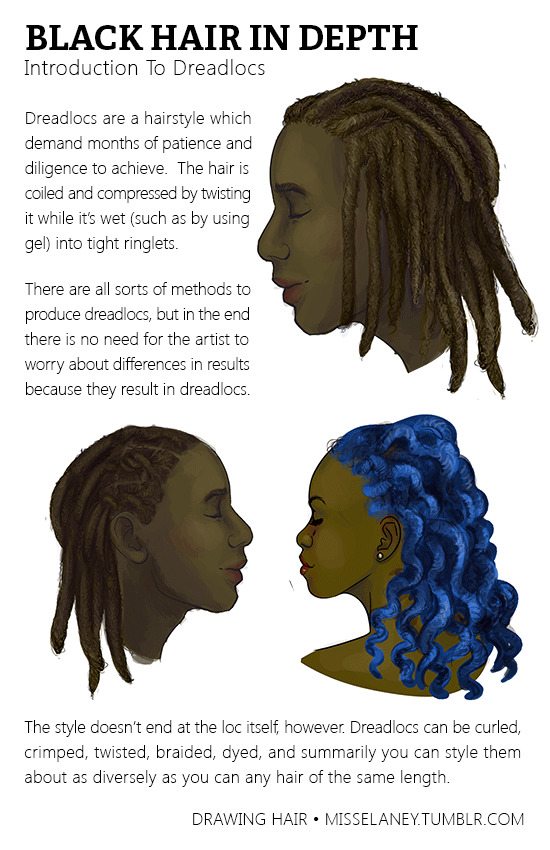

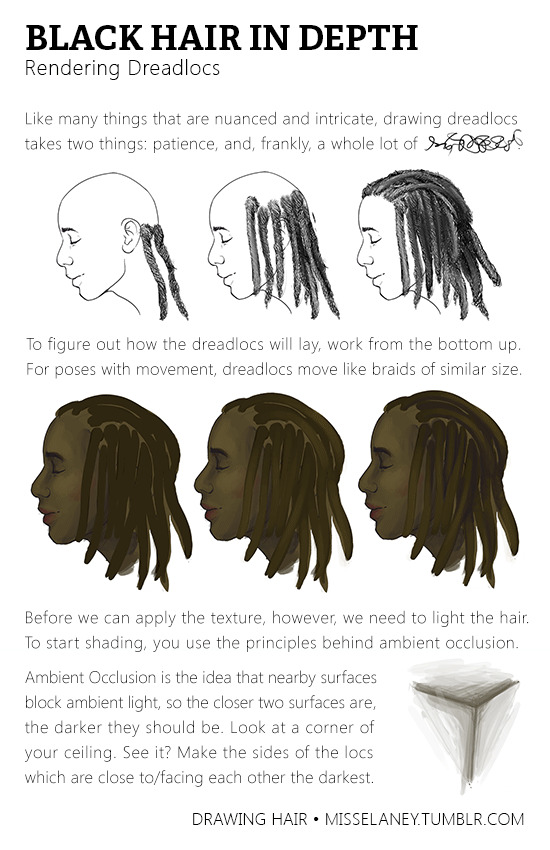
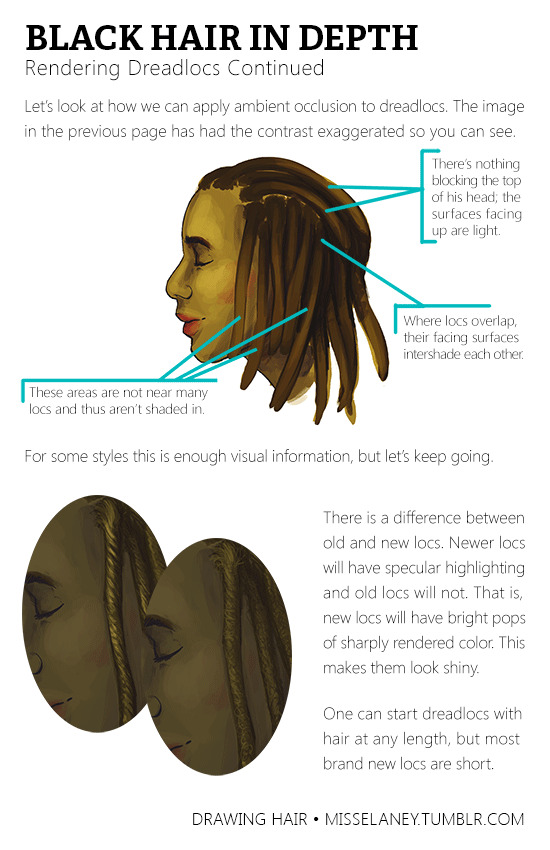

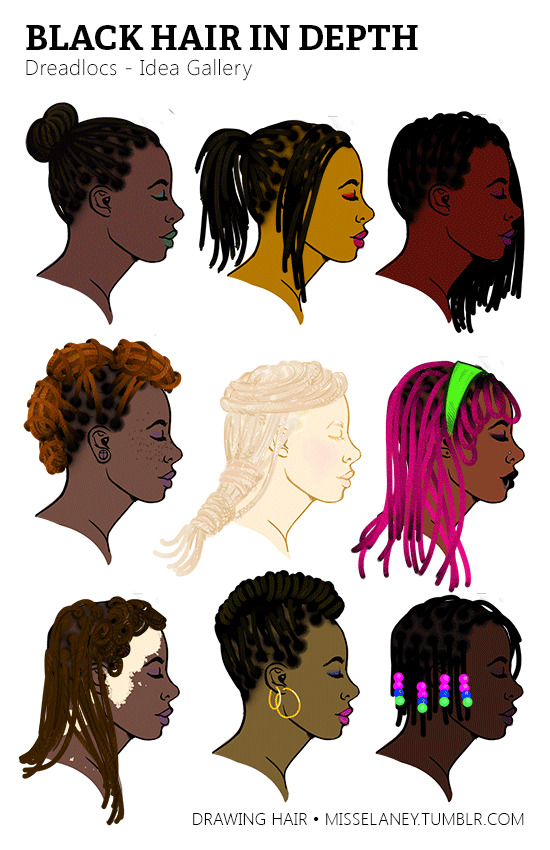

How to draw Dreadlocs!
See Part One: Rendering Natural Black Hair
Coming Up Next: VOTE by sending to my Ask box! (Until March 1st). Feel free to suggest any style or subject matter within drawing natural hair!
Questions? Comments? Tell me all about it!
Please help me concentrate more on this awesome tutorial series by subscribing to my Patreon!
87K notes
·
View notes
Text
society needs to be electra heartified again
12K notes
·
View notes
Text
Writing advice #?: Have your characters wash the dishes while they talk.
This is one of my favorite tricks, picked up from E.M. Forester and filtered through my own domestic-homebody lens. Forester says that you should never ever tell us how a character feels; instead, show us what those emotions are doing to a character’s posture and tone and expression. This makes “I felt sadness” into “my shoulders hunched and I sighed heavily, staring at the ground as my eyes filled with tears.” Those emotions-as-motions are called objective correlatives. Honestly, fic writers have gotten the memo on objective correlatives, but sometimes struggle with how to use them.
Objective correlatives can quickly become a) repetitive or b) melodramatic. On the repetitive end, long scenes of dialogue can quickly turn into “he sighed” and “she nodded” so many times that he starts to feel like a window fan and she like a bobblehead. On the melodramatic end, a debate about where to eat dinner can start to feel like an episode of Jerry Springer because “he shrieked” while “she clenched her fists” and they both “ground their teeth.” If you leave the objective correlatives out entirely, then you have what’s known as “floating” dialogue — we get the words themselves but no idea how they’re being said, and feel completely disconnected from the scene. If you try to get meaning across by telling us the characters’ thoughts instead, this quickly drifts into purple prose.
Instead, have them wash the dishes while they talk.
To be clear: it doesn’t have to be dishes. They could be folding laundry or sweeping the floor or cooking a meal or making a bed or changing a lightbulb. The point is to engage your characters in some meaningless, everyday household task that does not directly relate to the subject of the conversation.
This trick gives you a whole wealth of objective correlatives. If your character is angry, then the way they scrub a bowl will be very different from how they’ll be scrubbing while happy. If your character is taking a moment to think, then they might splash suds around for a few seconds. A character who is not that invested in the conversation will be looking at the sink not paying much attention. A character moderately invested will be looking at the speaker while continuing to scrub a pot. If the character is suddenly very invested in the conversation, you can convey this by having them set the pot down entirely and give their full attention to the speaker.
A demonstration:
1
“I’m leaving,” Anastasia said.
“What?” Drizella continued dropping forks into the dishwasher.
2
“I’m leaving,” Anastasia said.
Drizella paused midway through slotting a fork into the dishwasher. “What?”
3
“I’m leaving,” Anastasia said.
Drizella laughed, not looking up from where she was arranging forks in the dishwasher. “What?”
4
“I’m leaving,” Anastasia said.
The forks slipped out of Drizella’s hand and clattered onto the floor of the dishwasher. “What?”
5
“I’m leaving,” Anastasia said.
“What?” Drizella shoved several forks into the dishwasher with unnecessary force, not seeming to notice when several bounced back out of the silverware rack.
See how cheaply and easily we can get across Drizella’s five different emotions about Anastasia leaving, all by telling the reader how she’s doing the dishes? And all the while no heads were nodded, no teeth were clenched.
The reason I recommend having it be one of these boring domestic chores instead of, say, scaling a building or picking a lock, is that chores add a sense of realism and are low-stakes enough not to be distracting. If you add a concurrent task that’s high-stakes, then potentially your readers are going to be so focused on the question of whether your characters will pick the lock in time that they don’t catch the dialogue. But no one’s going to be on the edge of their seat wondering whether Drizella’s going to have enough clean forks for tomorrow.
And chores are a cheap-n-easy way to add a lot of realism to your story. So much of the appeal of contemporary superhero stories comes from Spider-Man having to wash his costume in a Queens laundromat or Green Arrow cheating at darts, because those details are fun and interesting and make a story feel “real.” Actually ask the question of what dishes or clothing or furniture your character owns and how often that stuff gets washed. That’s how you avoid reality-breaking continuity errors like stating in Chapter 3 that all of your character’s worldly possessions fit in a single backpack and in Chapter 7 having your character find a pair of pants he forgot he owns. You don’t have to tell the reader what dishes your character owns (please don’t; it’s already bad enough when Tolkien does it) but you should ideally know for yourself.
Anyway: objective correlatives are your friends. They get emotion across, but for low-energy scenes can become repetitive and for high-energy scenes can become melodramatic. The solution is to give your characters something relatively mundane to do while the conversation is going on, and domestic chores are not a bad starting place.
26K notes
·
View notes
Text
i have this writing style i like to call “uncertain.” it’s where the narrator isn’t really sure what they’re talking about either
82K notes
·
View notes
Text
PTSD isn’t just flashbacks. while a lot of movies, books, games etc equate post traumatic stress disorder to having extremely vivid flashbacks in which one thinks the trauma is happening again, this is not the only symptom of PTSD, nor is it a requirement for having the disorder.
other symptoms of PTSD include
problems sleeping
nightmares
hypervigilance (constantly checking surroundings for safety, looking for any possible threat)
being easily startled
being emotionally numb or not experiencing joy
seeing the world as a terrible place
memory loss
trouble relating to others
physiological or strong emotional reactions to reminders of trauma
intrusive thoughts about the trauma
(full list of criteria here)
flashbacks are not the be all and end all of PTSD. it’s a much more complex disorder than it’s portrayed in a lot of media, nor is it military exclusive. i hope this post can at least help educate some people beyond the incomplete and in some cases outright wrong information that a lot of people have.
40K notes
·
View notes
Text
EVIL character-driven outline

the sequel to my positive character arc outline, posted here. this outline connects your plot with a negative character arc, led by an anti-hero, a villain, an antagonist, or a plain old shitty person. suitable for any tragedy your heart might desire.
using the same explanations as in that post, with minor adjustments.
again, i combined save the cat, dramatica, and a character arc guide from this site to create a NEGATIVE character-driven outline, and based the format off of the “foody” method, seen in this video.
disclaimer that i’m not an expert!
here’s the link! to use, click make a copy or download.
(long) explanation under the cut
Keep reading
491 notes
·
View notes
Note
Hey, help me please. How do you write description in your novels? Not a character one, surrounding ones. How do you describe from 3 POV , the background of the novel?
5 Tips for Writing Great Descriptions
Hi there! Thanks for writing. I talk at length about this in my book The Complete Guide to Self-Editing for Fiction Writers (See Chapter 4 / “Building Your Story World,” Chapter 16 / Setting the Scene, and Chapter 21 / “Choosing the Right Details” for the majority of the discussion about description, but it’s peppered throughout), so I’ll just give a brief rundown here. :)
Tip #1: Use concrete, sensory details
That means describing, with precision, a detail you can see/hear/touch/taste/smell. Avoid using vague words that are hard to visualize or sense, like “the house was ugly” or “the weather was bad.” Instead, choose a sensory detail (or two) for your descriptions, for example “the house was a wretched shade of salmon pink” or “the wind was blowing I could taste dust in my mouth.”
Tip #2: Try not to over- or under-use descriptions
It’s common for beginning writers to either use no description, or go completely overboard. I give examples of both in my book. While there’s no hard rule about how much description is too little or too much (it depends a lot on the particular story, genre, and the writer’s style), I personally like to include around 4-5 sensory details per page.
The idea is to give the reader a solid sense of where they are without going on and on, making them want to skim over as you carry on for paragraphs about the smell and texture of a doily.
Tip #3: Use more description during important parts of the story
Description draws your readers attention to what you’re describing. Use that to your advantage. If that doily contains a blood stain that’s a pivotal clue in your murder mystery, by all means spend three sentences describing the particular color red of the blood or the weird smell it emits. Where you linger, the reader will linger.
Tip #4: Use description to set the scene
Use more description at the beginning of a new scene, or anytime the location of your story changes. I talk about this in the section on transitions in my book. Summary gets a bad reputation in fiction, but these transitional paragraphs are the perfect time to paint the scene with sensory details about your character’s surroundings.
Tip #5: Pay attention to “camera movement”
One common thing I see in writer’s manuscripts is what I call “jerky camera movement.” Here’s an example:
Jesse pulled into the driveway of the suspect’s mansion around noon. A white, floppy dog barked ferociously in the window. It was a warm, sweltering day. Jesse looked down and realized her shoe was untied. The house had three large columns in front, each wrapped with a gawdy red bow.
In this example, the “camera” moves from the driveway, to the dog in the window, to the “day,” to Jesse’s shoe, to the outside of the house. If that was your head, looking around the scene, you’d get dizzy pretty fast. Here’s a smoother movement, starting wide and focusing in on Jesse’s untied shoe.
It was a warm, sweltering day. Jesse pulled into the driveway of the suspect’s mansion around noon. The house had three large columns in front, each wrapped with a gawdy red bow. In the window, a white, floppy dog barked ferociously. As Jesse approached the door, she looked down and realized her shoe was untied.
These aren’t perfect examples because I’ve dashed them off just now, but you get the idea :) Try not to make your reader seasick by making them look all over the scene (unless you’re trying to achieve that effect, for example, in a scene where your protagonist is drunk or discombobulated).
Hope this helps!
2K notes
·
View notes
Text
anybody else just have the weirdest fucking relationship with the concept of god like. yes god is real. no i don't believe in him. the universe is on a prebuilt track and we cannot get off this ride. free will is an illusion. every decision you make changes every life you touch. there's no afterlife, only nonexistence. hell is real and i can list 10 people i know personally who are going there. god is in every tree and animal and blade of grass and person and every word that was spoken is spoken and will ever be spoken. when i die scatter my ashes where god can't reach me. god is a semi-permeable membrane. i am going to vandalize a church. y'know?
29K notes
·
View notes
Photo
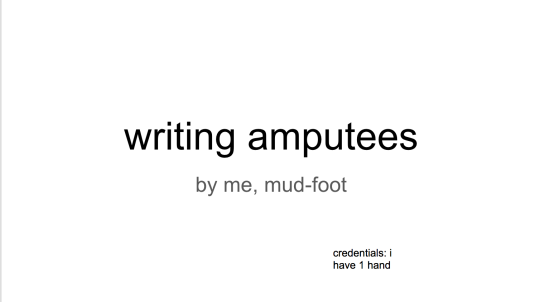



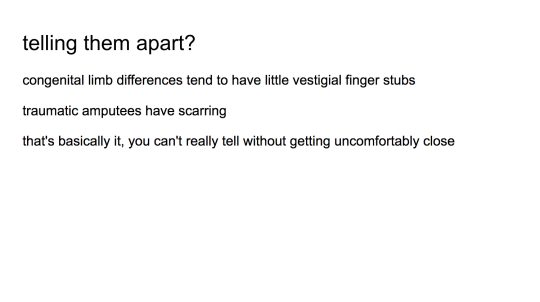




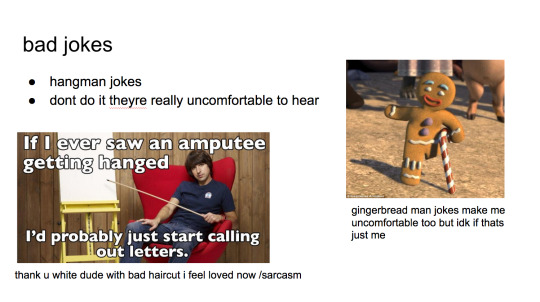
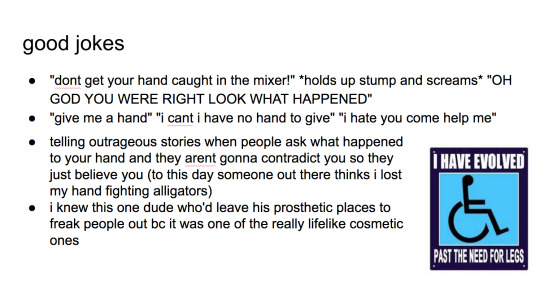

i made a guide for ppl
132K notes
·
View notes
Text
for all you writers out there:
donjon has tons of generators. for calendars. for demographics of a country and city. for names (both fantastical and historical) of people, nations, magics, etc.
this site lets you generate/design a city, allowing you to choose size, if you want a river or coast, walls around it, a temple, a main keep, etc.
this twitter, uncharted atlas, tweets generated maps of fantasy regions every hour.
and vulgar allows you to create a language, based on linguistic and grammatical structures!!! go international phonetic alphabet!!!
61K notes
·
View notes
Note
how do i write when i have adhd and cant even outline the first three chapters:( i always get stuck after three, get bored, and never come back. any advice ?
Writing with ADHD (by a writer w/ adhd)
1. Consume caffeine and/or do cardio for 30min before sitting down to write. Listen to music, a themed playlist perhaps. Do not log onto the internet or have any distractions nearby (books, pets, clutter, food, unfinished projects). Keeping a dohickey like a stress ball around or even a lightweight dumbbell is a decent proxy when your brain craves distraction. Chewing gum can also help you focus.
2. Don’t outline by chapter, I cannot get farther than five or six when I do that. Outline from beginning to end, but make sure to have a middle! Write a synopsis of what happens and break it into chronological chunks. Only outline by chapter once you’ve got a general outline of the whole story, and even then only outline a couple chapters at a time.
3. Write whatever comes to you, but keep it in order in your document. You want to write how your character discovers a secret, but you know that’s not until chapter 20. Write it anyway and title it chapter 20. Do this with every scene you’re inspired to write, then slowly fill in the gaps. If that proves difficult, it’s okay to make the reveal chapter 9 instead and connect everything with [and then this happened] so you’ll know to sew it up later.
4. However short or long the story ends up being, finish it. You can set a goal of 30 chapters, but if 10 is easier finish by chapter ten. Come back (much) later, reread, and add any new ideas you come up with. A short story is sweet! A novella is nice! Train your brain to write longer passages until it can achieve a story of the length you want.
5. (optional) Outlining is for people who can focus, just start writing somewhere and figure it out along the way. I had a very general outline for my longest novel, but mostly I made everything up and ignored it. Maintain focus, know your end goal, and even if you stumble there and take some shortcuts it still counts. Any messiness can be improved in future drafts.
+ Please review my Ask Policy before sending in your ask. Thank you!
+ If you benefit from my updates and replies, please consider sending a little thank you and Buy Me A Coffee!
+ HEY, Writers! other social media: Pinterest - Wattpad - AO3 - Goodreads
10K notes
·
View notes
Text
I'd like you to think about me but also please don't ever perceive me or notice my existence, thx
334 notes
·
View notes
Text
No, not the sound—it was her body’s hunger
finally evident—what our mother had hidden all her life.
For months I dreamt of knucklebones and roots,
the slabs of sidewalk pushed up like crooked teeth by what grew underneath.
The underneath. That was the first devil. It was always with me
And that I didn’t think you—if I told you—would understand any of this—
Marie Howe, from “Magdalene—The Seven Devils”
24 notes
·
View notes
Text
Your power is out but I guide you down the hallway with my sickass light-up shoes
85K notes
·
View notes
Text
WIP Hospital: Overdose

An overdose is essentially what happens when someone overindulges in drugs or surpasses a dose leading to health problems that could endanger life.
Remember, somebody loves you. Stay safe, stay clean and keep fighting.
How Overdosing Occurs
Overdosing can occur both accidentally or on purpose. Common occurences happenwhen the participant has no idea how strong the dose is, takes a regular dose after tolerance has lowered (usually when an addict stays clean after a period and then takes up the habit again), taking a larger dose than accustomed to or combining substances of abuse or intends to harm themselves
Kinds of Drugs
Dissociative drugs: Dissociative drugs alter perception leaving the participant feeling a disconnection with the world around them. Examples: Ketamine and nitrous oxide
Depressants: Or sedatives calm the participant, slowing the breathing and reaction of the participants. Examples, GHB and benzodiazepines
Stimulants: Stimulants are the opposites of sedatives, perking up and hypering the participant. Examples: Cocaine and amphetamines
Psychedlics: Are an 'Hallucinogenic' drug. They cause changes in perception, thought, emotion and consciousness, altering yhr mind. Example: LSD, Mushrooms
Opioids: Are made of extracts of poppy or opium. They decrease pain and sensation in the participant. Example: heroin, morphine, codeine, heroin and methadone. They are classed as narcotic analgesics - meaning they decrease pain reaction and sensation.
Handling an Overdose in your Characters
Opioid Overdose
Signs: lethargy, bluish tinge to fingers and lips, pinpointed pupils, unresponsive, unconsciousness, trouble with breathing (such as shallow breathing) or lack of breathing.
Response: Remove impediments that could further injure, try rouse the person (if they wake, keep them talking), check airways and perform CPR if needed, wait for ambulance to escort patient to hospital (where Naloxone will be administered to the patient)
Stimulant Overdose
Signs: Elevated heart rate, chest pain, shaking/seizures, hyperness, sweating, flushed skin, disorientation, elevated breathing, irritability.
Response: Remove dangers such as needles and anything of a danger, reassure patient if awake and disoriented, loosen clothing, put in recovery position
Psychedelic Overdose
Signs: Erractic Behaviour, signs of distress, excessive sweating, dilated pupils, numbness, spasms, anxiety, paranoia
Response: Remove them from dangerous environments, avoid sensory overload, you have have to keep them from others.
Dissociative Overdose
Signs: Spasms, Respiratory troubles, stupor,
Response: Remove needles or other harms from the patient, reassure patient if awake and disoriented, loosen clothing, put in recovery position and call ambulance
Depressants Overdose
Signs: Unconsciousness, incoherency, sweating, vomiting, irregular or shallow breathing, spasms, elevated heartrate, breathing problems,
Response: Remove impediments that could further injure, try rouse the person (if they wake, keep them talking), check airways and perform CPR if needed, wait for ambulance to escort patient to hospital
159 notes
·
View notes
Text
A Note on Writing Kind Characters
We often judge a character’s kindness the same way we would the Powerpuff Girls: are they made of sugar, spice, and everything nice? I’m here to tell you that while sweetness can be indicative of kindness, it is not synonymous with it.
Characters are not only kind because they cannot fathom being cruel. Characters can be kind because they know just how cruel they can be and opt for compassion instead.
Characters are not only kind because they think nothing of themselves and only think of others. Characters can be kind because they desperately want someone to show them the same consideration after a lifetime of manipulation and rejection.
Characters are not only kind because they love to help with every little issue. Characters can be kind because they fear what will happen if they’re not, if no one else rises and all goodness falls away - and they see the same uncertainty in the person they’re assisting.
Characters are not only kind when they keep their mouths clean and their words affable. Characters can be kind by delivering painful truths while the world would let you live with honeyed lies, but they’ll help you grieve and grow from them.
Yes, your characters can be pure, selfless, innocent angels. They can cute as a button and sweet as pie! But they can also be human: healing others instead of harming them because of the hurt they know they could bring about. Instead, these characters - flawed and damaged as they may be - choose kindness.
2K notes
·
View notes